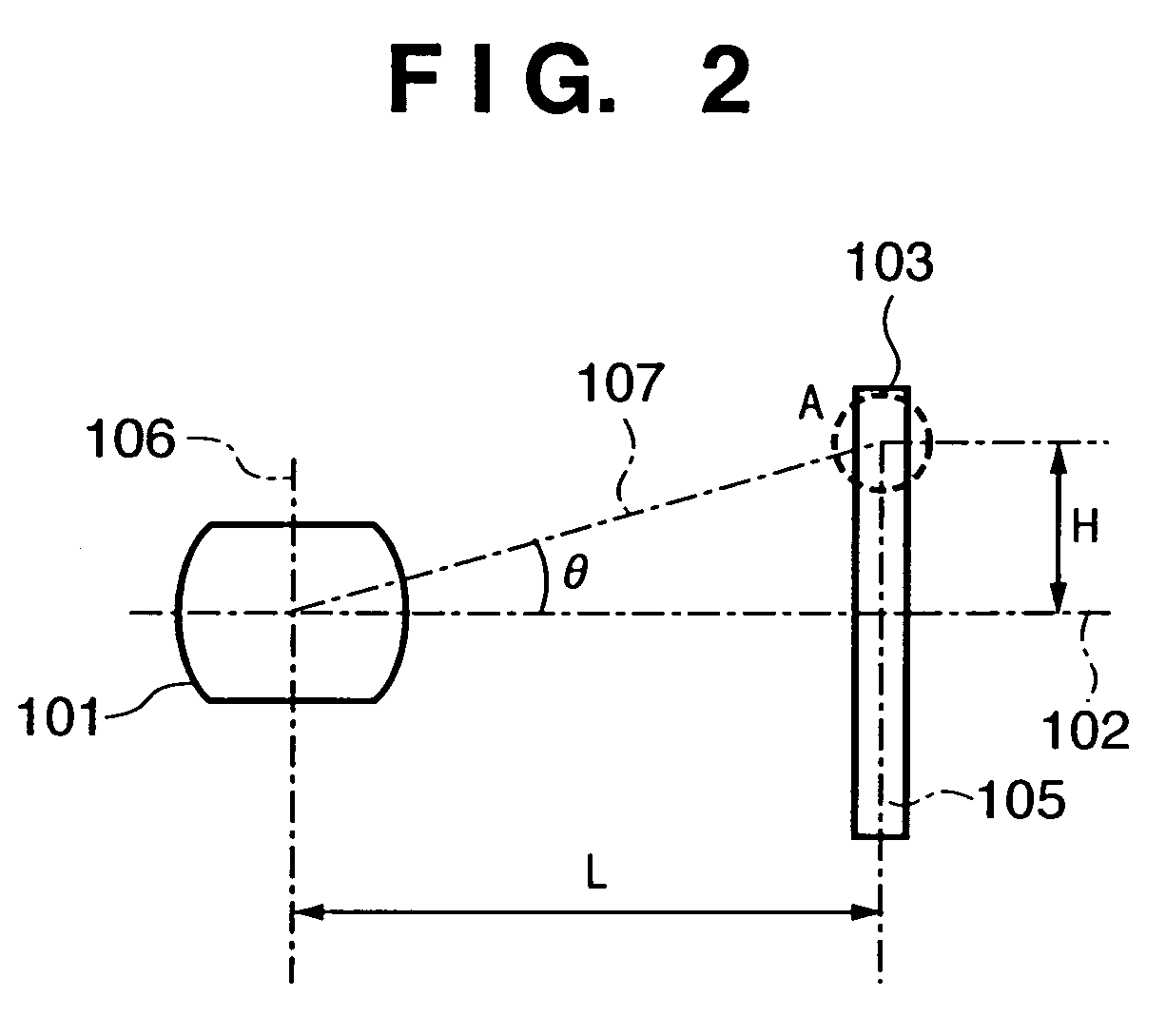Solid-state image sensing element and its design support method, and image sensing device
a technology of image sensing element and design support method, which is applied in the direction of radioation control device, television system, instruments, etc., can solve the problems of light rays not being able to enter the photoelectric conversion unit, phenomenon posing severe bottlenecks, and frame periphery often becoming dark, so as to improve the degree of design freedom and high light collecting efficiency
- Summary
- Abstract
- Description
- Claims
- Application Information
AI Technical Summary
Benefits of technology
Problems solved by technology
Method used
Image
Examples
first embodiment
[0097]The relationship between the solid-state image sensing element 200 and pupil redundancy in the first embodiment will be described below.
[0098]As shown in FIG. 2, since the angle the chief ray 107 makes with the optical axis 102 is θ, we have:
[0099]tanθ=HL(1)
Based on this, the relationship among the image height H, pupil distance L, pixel pitch P, height D, refractive index NH of the light guide 203, and refractive index NL of the insulating interlayer 211 is given by:
[0100]H·DL·P<a·NHNL(2)
When the image height H, pupil distance L, pixel pitch P, height D, refractive index NH of the light guide, and refractive index NL of the insulating interlayer are selected to make the coefficient a meet:
0
the effect for the photo-receiving efficiency of the light guides structure can be improved.
[0101]Inequality (2) will be described in detail below.
[0102]FIGS. 7A and 7B are views for explaining the relationship between the refractive index of the light guide 203 and the critic...
second embodiment
[0149]FIG. 14 is a side sectional view showing a schematic structure of a digital color camera as an image sensing device according to the present invention. This camera is a single-plate type digital color camera using an image sensing element such as a CCD, CMOS sensor, or the like, and obtains an image signal indicating a moving or still image by driving the image sensing element continuously or in a one-shot manner. Note that the image sensing element is an area sensor which converts incoming light into charges according to the amount of light, accumulates the charges for respective pixels, and reads out the accumulated charges.
[0150]Referring to FIG. 14, reference numeral 110 denotes a camera body; and 126, a lens device which includes an image sensing lens 125 and is detachable from the camera body 110. Note that FIG. 14 depicts only one lens as the image sensing lens 125. However, the image sensing lens 125 is normally formed by combining a plurality of lenses. The lens devic...
third embodiment
[0220]Furthermore, in the third embodiment, the flattening layer 39 is formed using silicon oxide (SiO2), and the micro convex lens 902 of titanium oxide (TiO2) is formed by etching the upper portion of the flattening layer 39 in a concave shape, forming a titanium oxide (TiO2) layer on top of the etched flattening layer 39, and etching the upper surface of the titanium oxide layer in a convex shape.
[0221]Since the refractive index of silicon oxide (SiO2) that forms the flattening layer 39 is 1.46, and that of titanium oxide (TiO2) that forms the micro convex lens 902 is 2.35, the micro convex lens 902 has a focal length as a convergence system. Therefore, even when there is intervals between the neighboring embedded transparent resin layers 36, a light beam passes through the micro convex lenses 902 which are bedded without any interval, and is efficiently focused on any of embedded transparent resin layers (silicon nitride) 36.
[0222]In this way, the same effect as in the second em...
PUM
 Login to View More
Login to View More Abstract
Description
Claims
Application Information
 Login to View More
Login to View More - R&D
- Intellectual Property
- Life Sciences
- Materials
- Tech Scout
- Unparalleled Data Quality
- Higher Quality Content
- 60% Fewer Hallucinations
Browse by: Latest US Patents, China's latest patents, Technical Efficacy Thesaurus, Application Domain, Technology Topic, Popular Technical Reports.
© 2025 PatSnap. All rights reserved.Legal|Privacy policy|Modern Slavery Act Transparency Statement|Sitemap|About US| Contact US: help@patsnap.com



